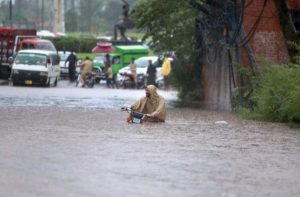MANHATTAN: One in three children or 739 million worldwide already live in areas exposed to high or very high water scarcity, with climate change threatening to make this worse, according to a new UNICEF report.
Further, the double burden of dwindling water availability and inadequate drinking water and sanitation services is compounding the challenge, putting children at even greater risk.
The report, a supplement to UNICEF’s Children’s Climate Risk (2021), also outlines the myriad of other ways in which children bear the brunt of the impacts of the climate crisis –including disease, air pollution, and extreme weather events such as floods and droughts.
From the moment of conception until they grow into adulthood, the health and development of children’s brains, lungs, immune systems and other critical functions are affected by the environment they grow up in.
For example, children are more likely to suffer from air pollution than adults. Generally, they breathe faster than adults and their brains, lungs and other organs are still developing.
“The consequences of climate change are devastating for children,” said UNICEF Executive Director Catherine Russell.
“Their bodies and minds are uniquely vulnerable to polluted air, poor nutrition and extreme heat.
“Not only is their world-changing – with water sources drying up and terrifying weather events becoming stronger and more frequent – so too is their well-being as climate change affects their mental and physical health.
“Children are demanding change, but their needs are far too often relegated to the sidelines.”
According to the report findings, the greatest share of children are exposed in the Middle East and North Africa and South Asia regions – meaning they live in places with limited water resources and high levels of seasonal and interannual variability, groundwater table decline or drought risk
Far too many children – 436 million – are facing the double burden of high or very high water scarcity and low or very low drinking water service levels – known as extreme water vulnerability – leaving their lives, health, and well-being at risk.
It is one of the key drivers of deaths among children under 5 from preventable diseases.
The report shows that those most affected live in low- and middle-income countries in sub-Saharan Africa, Central and Southern Asia, and Eastern and South-Eastern Asia.
In 2022, 436 million children were living in areas facing extreme water vulnerability. Some of the most impacted countries include Niger, Jordan, Burkina Faso, Yemen, Chad, and Namibia, where 8 out of 10 children are exposed.
In these circumstances, investment in safe drinking water and sanitation services are an essential first line of defense to protect children from the impacts of climate change.
Climate change is also leading to increased water stress – the ratio of water demand to available renewable supplies – the report warns.
By 2050, 35 million more children are projected to be exposed to high or very high levels of water stress, with the Middle East and North Africa, and South Asia currently facing the biggest shifts.
Despite their unique vulnerability, children have been either ignored or largely disregarded in discussions about climate change.
For example, only 2.4 per cent of climate finance from key multilateral climate funds support projects that incorporate child-responsive activities.
Newspakistan.tv/APP/AFP











